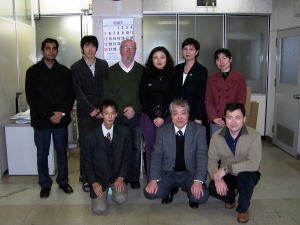Over the Years
Home > Over the Years > Over the Fiscal Years (2000 APR - 2010 MAR) > Kazakhstan: Doctor and Researcher Training Program
Kazakhstan: Doctor and Researcher Training Program
HICARE invited both a physician and a researcher from the Scientific Research Institute of Radiation Medicine and Ecology for one month of training at the Hiroshima University Research Institute for Radiation Biology and Medicine.
Name and Position:
Berekenova Gulnar Abubakirovna
Chief, Clinical Radiology Department
Scientific Research Institute of Radiation Medicine and Ecology
Argembaeva Raushan Maxutovna
Junior Scientific Researcher
Scientific Research Institute of Radiation Medicine and Ecology
Period:
January 25 to February 17, 2006
Training Organization (in order of occurrence):
Hiroshima University Research Institute for Radiation Biology and Medicine
Radiation Effects Research Foundation
Hiroshima A-bomb Casualty Council
Training Course:
Radiation dosimetry

Dr. Gulnar and Dr. Raushan (the second and third from the right in the back row) with training staff at the Hiroshima University Research Institute for Radiation Biology and Medicine
Impressions:
Berekenova Gulnar Abubakirovna:
HICARE's training program was very well managed. In addition to the medical training in Hiroshima, I was privileged an opportunity to get in touch with Japanese culture. The staff of HICARE took wonderful care of us during our stay in Hiroshima. I would personally like to cordially thank HICARE for their hospitality.
I hope that HICARE continues its activities into the future. I would like people around the world to know about HICARE and its work. Again, I would like to express my deep appreciation for HICARE's efforts. Medical experts in Semipalatinsk are earnestly working to aid all radiation victims. We are thankful for, and hopeful for, your continued support with regards to radiation health care in the Semipalatinsk region.
Medical activities in Kazakhstan:
I am working at the Clinical Radiation Department of the Scientific Research Institute of Radiation Medicine and Ecology in Semipalatinsk. Our affairs are directly related to the support of radiation victims. In spring, summer, and autumn, researchers (doctors in various fields such as endocrinology, the oral cavity, gynecology, neurology, functional diagnosis,etc.) visit radiation-exposed regions and support patients via various medical examinations. Examples:
- Screening tests by physicians
- In the case of an abnormality, after examining the patient at the doctors affiliated institute or hospital and making a final diagnosis, each expert refers them to the city hospital.
- Patients can stay and receive medical treatment at the institute once a year.
Services are provided free of charge.
I suppose that the above-mentioned support is the bare minimum that one would expect for a patient. Due to the current development of our economy, we may be able to provide more robust support in the future.
I am privileged to be participating in this medical support team as an oral specialist. Additionally, as the member in charge of medical examination arrangements, I perform the procedures necessary for treatment of patients requiring oral/jaw treatments.
Argembaeva Raushan Maxutovna:
HICARE's training program is very beneficial. Like other trainees, I learned a lot, observing the studies and procedures of numerous Japanese scientists. I visited the Hiroshima Peace Memorial Museum while I stayed in Hiroshima. I was interested in the lectures there. Observing how Japanese doctors work both with and for their patient, I learned a lot about courtesy and bedside manner. HICARE's staff was very kind, polite, and patient.
Medical activities in Kazakhstan:
At present, I am working at the Equipment Operation and Rehabilitation Department of the Scientific Research Institute of Radiation Medicine and Ecology in Semipalatinsk. Currently, the institute is making a database of nuclear test radiation victims from the Semipalatinsk region. Collecting the information in the East Kazakhstan State, the staff, including myself, is currently filling in the data. We are currently conducting radiation dosimetry there. We have already carried out a questionnaire targeting residents in both Dolon and Mostik village. We are trying to confirm how they were living, where they were working, and where they were staying during the first nuclear tests.
All of these procedures are necessary to estimate the quantity and effects of the nuclear testing radiation.




